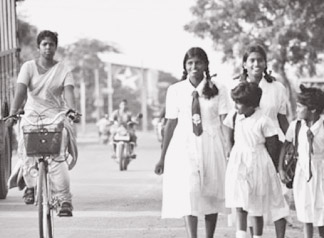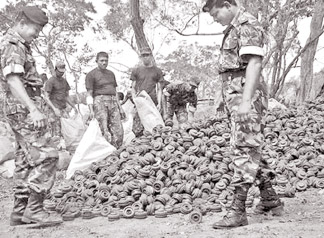A country in revival
|

Their future is not so bleak |
With the protracted terrorist conflict coming to an end in May 2009,
Sri Lanka is now one of the most peaceful countries in the world. The
Sri Lankan Security Forces conducted one of the largest humanitarian
operations in the modern history of the world to rescue the country and
its people from terrorism, which had brought in a reign of death,
destruction and unspeakable misery on a once peaceful and resplendent
nation.
It is noteworthy to mention that within a short period of three
years, a conducive environment has been successfully created where
democratic pluralism, social cohabitation and economic freedom could
flourish.
Sri Lanka is now a country in revival. Not only did it set an example
to the world in successfully defeating terrorism, but also in
post-conflict recovery and development. The post-conflict challenges
were many.
To overcome these challenges, a national framework was drawn that
constituted the 5R (Reconstruction, Resettlement, Rehabilitation,
Reintegration and Reconciliation) concept. Once again, the Security
Forces played a pivotal role in this national endeavour.
Pressing issues
One of the most pressing issues that needed the urgent attention of
the State was the welfare of the nearly 300,000 displaced persons who
were held as a human shield and a bargaining chip by the terrorists.
The rehabilitation of about 12,000 surrendered combatants was another
burning issue. The State machinery was put to work under a well-planned
strategy.
Initially, the displaced were housed in five welfare villages: four
in the Vavuniya district, including Menik Farm, and one in Mannar.
These welfare villages were provided with electricity, cooking areas,
toilets, bathing areas and child-friendly spaces. Provision of water
exceeded World Health Organization requirements, and all sanitation
facilitates were maintained to a good standard.
A ‘six plus one’ rehabilitation process model was adopted for the
beneficiaries of the rehabilitation program. The adult beneficiaries of
rehabilitation were initially housed in 22 Protective Accommodation and
Rehabilitation Centres (PARC) maintained by the Bureau of the
Commissioner General of Rehabilitation. A special rehabilitation program
was organised for child soldiers. A special program for ‘catch up
education’ was provided for young adults to continue their education.
Meaningful activities
|

Some of the mines recovered by Security Forces personnel |
All beneficiaries were provided with extensive training programs that
were designed to de-radicalise and to equip them with the ability to
reintegrate and resume normal life in their societies.
Due to its uniqueness and success, Sri Lanka's rehabilitation program
has come under international acclaim. Before any meaningful development
activities can take place in the former theatre of conflict, the area
had to be demined.
It was suspected that the LTTE had heavily mined about 5,000 square
kilometres of land. The entire demining process was prioritised,
carefully planned and executed. Priority areas were chosen to maximise
the efficiency and speedy return of the displaced.
Towns and villages were first demined followed by agricultural areas
and forests.
By June 2012, 469,275 anti-personnel mines, 1,399 anti-tank mines and
388,963 unexploded ordnance devices had been recovered by the Security
Forces and other demining organisations. At present, only a very small
area remains to be demined.
With most of the areas being cleared of mines, the resettlement of
displaced persons got off the ground. Most of the infrastructure
development work was carried out under the ‘Northern Spring’ and
‘Eastern Reawakening’ programs.
Renovation of the road and rail network, power and water supply and
irrigation work were expedited. Funds were allocated to renovate
existing school buildings and construct new ones.
Much emphasis was laid on uplifting the health care and sanitation
facilities. Stringent measures were taken to ensure the welfare of the
resettled communities.
Poverty alleviation
Poverty alleviation and people empowerment programs were carried out
to improve the quality of life and harmonise civil society with
sustainable livelihoods in the affected areas. With the successful
resettlement of the displaced, the welfare villages were eventually
closed.
The rehabilitated former combatants were gradually reintegrated into
their societies. Special provisions were made available to them to
adjust to the new environment and also to find ways of sustenance. A
large number of these youth were recruited to the Civil Defence
Department.
As a trust-building initiative, youth from the North and the East
were recruited to the Police. Recently, 100 Tamil females from
Kilinochchi and Mullaitivu joined the Army. This reflects the trust that
the Northern masses have on the reconciliation process. Thousands of
Northern graduates have also received State sector employment.
With the eventual lifting of security zones in the peninsula, freedom
of movement was ensured and as a result, civil life is flourishing.
Since July 2011, more than 51,400 foreign passport holders from over 100
countries have visited Sri Lanka and travelled to the North.
In stark contrast to the dark days of LTTE reign, more Southerners
also visit the North now. Colombo-based business houses and
conglomerates are rushing in to set up shop there.
The country is at last breathing a sigh of relief and enjoying the
dividends of peace after going through three decades of death,
destruction and mayhem.
After saving the nation from terrorism, now the Tri-Forces are
involved in another humanitarian operation, to assist in the development
of the country. Sri Lanka is slowly recovering from its horrific past.
For the sanguine, the future is bright, but for some elements, it is
unfinished business. There are concerted efforts to destabilise the
hard-won peace. It is the duty of all peace-loving citizenry to rally
round the country and protect its integrity and hard-won freedom.
- defence.lk
|



